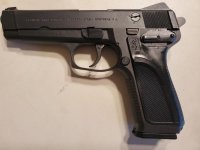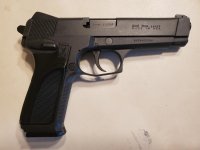I have a Browning BDM (top) as well as an FN HP-DA (middle) and a Browning SFS Hi Power (bottom) for a partial collection of Hi Power descendents that didn't succeed.
SFS Hi Power
I bought my SFS Hi Power new at less than half the regular Hi Power price when FN was closing them out. The SFS Hi Power is identical to the Mk III Hi Power with the exception of a revised safety lever and some different fire control parts that are interchangeable with the regular Hi Power parts, so while FN sold the SFS Hi Power from the factory you can convert any Hi Power to the SFS configuration and you can convert any SFS Hi Power back to the regular configuration.
The SFS design originated as FN's submission for the 1977 round of the XM-9 pistol trials, but it was disqualified as it was not a DA pistol. The design was modified a bit before it was released by FN for commercial sales about a decade later. FN marketed SFS Hi Powers while Browning did not. You can however still get original FN SFS conversion kits from Cylinder and Slide.
The SFS system operates a bit differently than a regular Hi Power. The hammer is a two piece unit where the lower part remains fully cocked under pressure from the hammer spring. The upper portion, when pressed forward, rests against a hammer block and raises the safety lever to the "safe" position. When you press the safety lever down to the "fire" position, the upper portion of the hammer snaps back to the upright position against the lower portion of the hammer.
The end result is that the SFS Hi Power is carried in condition 1, but the hammer appears to be lowered when the safety is on. That has the advantage of not scaring citizens as much as a 1911 in condition 1 by a police officer as it doesn't appear to be cocked. It's also convenient for concealed carry as the hammer won't rub on your side, it's very easy to confirm the pistol is on "safe" and any time you put your thumb behind the hammer to holster it, it'll be on "safe".
I shot several practical pistol matches with it and had to explain it to several ROs who were concerned I was starting in Condition 2.
I like the system and I've converted one of my FEG P9 pistols to SFS status.
FN HP-DA
The FN HP-DA was developed for round two of the XM-9 service pistols trials in 1983 after the failure of the SFS Hi Power to qualify for the 1977 trials. It was intended to be more or less a DA version of the Hi Power, but it shares almost nothing with the Hi Power other than the locking system.
It uses the Hi Power locking system, with an SA/DA trigger, a decocking lever and a trigger operated firing pin safety. I like the grip on the Hi Power, but that same feel is missing from the HP-DA. The combination of slightly wider grip and a slightly too long trigger reach is my major objection to the HP-DA.
The FN "HP-DA" was primarily marketed in Europe and was sold in the US as the Browning "BDA". The FN HP-DA had 10 round and 15 round magazine while the Browning BDA used a different but interchangeable 14 round magazine. There were also two compact models, the mid sized BDAM and the compact BDAC. There was also a DA only model, the BDAO.
It was marked commercially after the pistol trials but was discontinued in 1987 due to poor sales. However, in 1990 FN resurrected the HP-DA, marketing it as the Browning BDA9 and the BDAO in the US and by FN as the HP-DA and HP-DAO (again a DA only version), primarily in Europe.
These later pistols had some minor changes such as the larger triangular de-cocking lever, but again didn't sell all that well in the US. Popular wisdom is that they were discontinued in 1999, but mine has the MM date code, indicating it was made in 2000.
Browning BDM:
As noted above the Browning BDM was designed for the FBI service pistol trials in 1991. Once again Browning put it into production for civilian sales and it remained in production until 1998. However, unlike the HP-DA, the BDM was only produced by Browning and was not produced by FN for European sales.
The "DM" in BDM refers to "Dual Mode" and consequently, it has a switch on the left side of the slide can be rotated to change the operation from a normal DA/SA pistol function, to a DA only revolver type operation where the pistol de-cocks after each shot to provide a consistent DA trigger pull. In the event you drop the hammer on a dud round and re-pull the trigger to try it again, it will have a slightly longer DA pull, as the default position for the de-cocked hammer is more of a quarter cock position. But for the usual DA pull from the de-cocked position, it has a typical DA revolver length and reset, but one that is slightly less smooth than most of my Ruger and S&W revolvers.
Browning also made variations in the form of the BRM (Browning Revolver Mode) which functioned like a DAO revolver and the BPM-D which stood for Browning Pistol Mode - Decocker. These were essentially BDMs without the switch operating in just one mode or the other.
As noted above the BDM has a very thin grip for a double stack magazine 9mm pistol. The thin grip lends itself to easy concealment, a desirable feature for FBI use. The BDM also has a commensurately short trigger reach, which makes it very easy to get enough finger on the trigger to give you excellent leverage for the DA trigger pull.
The BDM beside the HP-DA:
The BDM and HP-DA both weight the same 31.5 oz empty, but the BDM is much better balanced and feels much better in the hand. Both pistols share the same styling changes in terms of angled slide and frame profile, squared trigger guard, have similar wrap around grips, and have provisions for a lanyard loop, but the BDM is significantly thinner.
Another significant difference is the much smaller slide release on the BDM. That, along with the raised ears on the rear of the slide clearly indicate it was designed exclusively for the "slingshot" method of slide release.





